It looks like you're using an Ad Blocker.
Please white-list or disable AboveTopSecret.com in your ad-blocking tool.
Thank you.
Some features of ATS will be disabled while you continue to use an ad-blocker.
share:
When we take a look at pictures and videos presented to us here on ATS of UFOs, I have noticed a lot of observations by members that seem to show a
lack of understanding of things like perspective views, photography and telescope optical systems.
The idea behind this thread is not to "debunk" anything, but instead to try and help ATS members be better observers in this field. Knowledge is power, and being informed on how things work can help enable a person's observational skills.
With the power of the internet in today's world, we have a multitude of people who can now cruise the internet and come upon all sorts of images and videos that people have posted and claimed that they are UFOs.
This has allowed any memeber here on ATS to watch a video on YouTube, or find a picture posted somewhere, and in turn bring it here to ATS for others to see. This can be a very powerful thing as it allows a large number of people to examine something.
However, part of the problem is that many times we have pictures and videos of things that memebers look at, but they lack the knowledge or education of the device that was used to take that picture or video.
Good examples of this are pictures or videos taken by satellites such as SOHO or STEREO, and ATS members will make posts that state such things as:
"That thing is HUGE!"
"That thing is right next to the sun!"
The problem with statements like these, is that in most cases, there is no way to really tell the size of the object or it's distance from the camera!
Let us take a look at what we call "Perspective View":
Using one of my computer SDKs (Software Development Kits), I've created a globe of the Earth. I've also created a very large object and set it next to the Earth as you can see in the picture below:
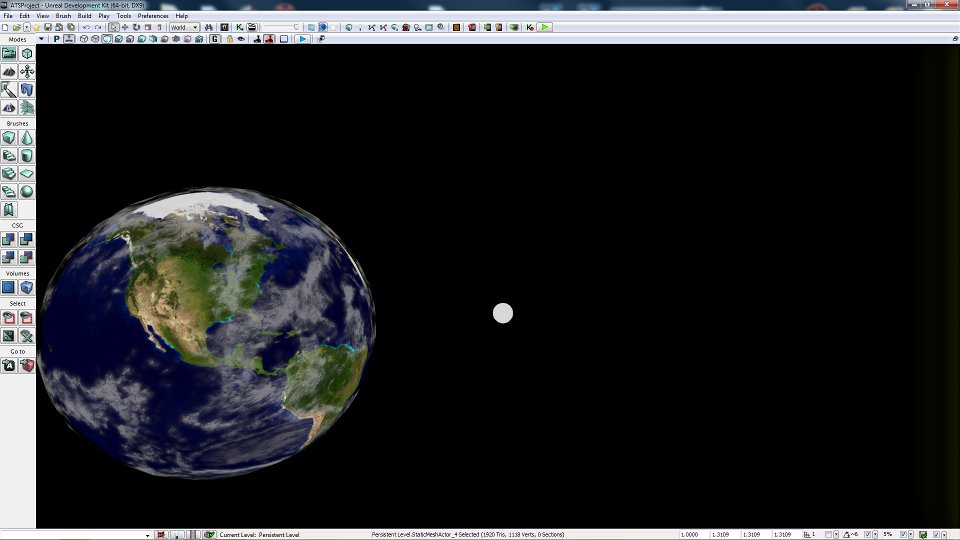
Let us imagine that we are a satellite that has imaged this.
Now let us take a look at the large white sphere from a different angle and much closer, with a reference object. The referece object is a large rock. I've sunk it into our large sphere:
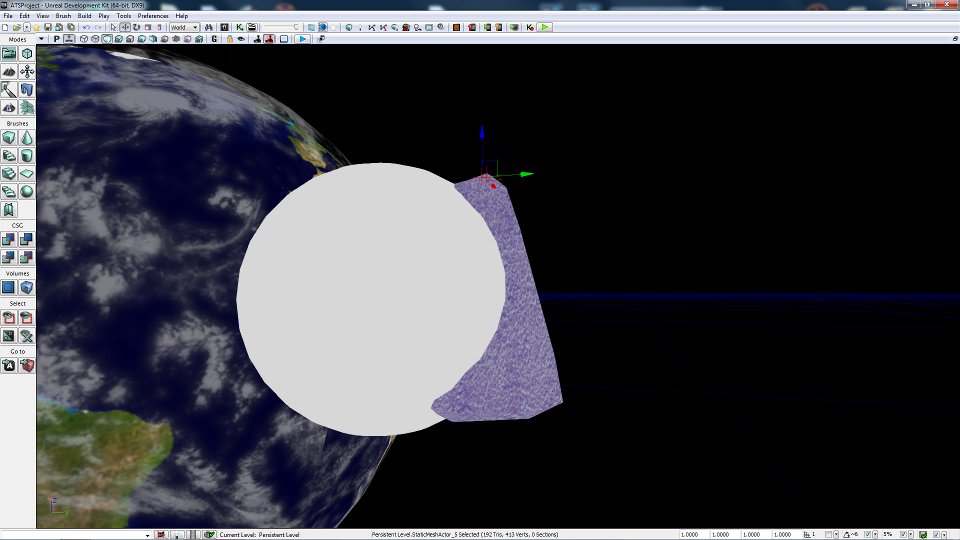
As you can see, the white sphere is with out a doubt, a large object by the Earth.
Now take a look at this picture:

It looks the same as our first one: a large object next to the Earth.
But there is a problem here. We are assuming that this is a large object right next to the Earth. We did that with my first picture too actually.
But here is what this object in this picture really is:

It's a very small object, very close to the camera. There is my reference rock, and I've even put the actual large white sphere where it was before.
So when looking at these pictures and videos, before you state that it's something large and next to the sun (or another body), keep in mind that you do not know this for a fact without a change in perspective or some sort of reference.
Is there no way to tell from these pictures or videos?
Actually, there is a way to at least make what we call an "educated guess" of how far or close something might be.
It's called "Focus"
This is where understanding the device that took the image or video comes into play.
Many of the satellites in orbit have different types of imaging systems on them. Understanding how they work is very important if you want to understand what you might be looking at.
Some of these systems use telephoto types of lens. Some use reflective optics. The reasons for this is due to what type of focal length the camera needs.
The correct type of telephoto lens can zoom in on objects that are far away. The amount of zoom we get will depend on the optic's focal length. Here is a picture that shows the more we zoom in, the larger the focal length:
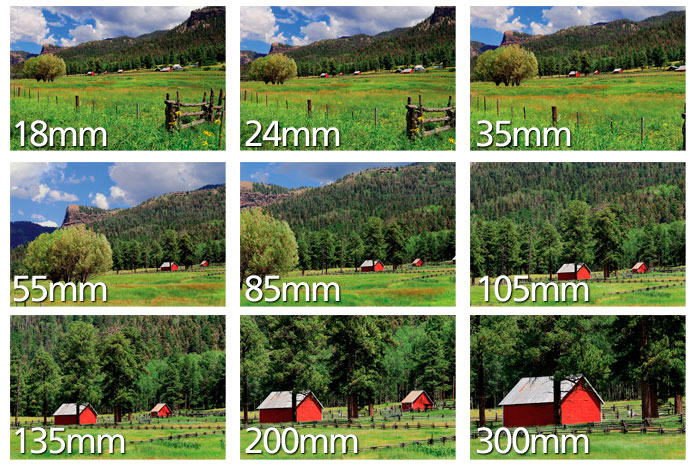
Telephoto lenses start to get large and heavy the larger you go. If you want even higher zoom capabilities, you'll start running into the problem of lens size. Making huge lenses for much higher focal length is a problem in that the glass when forming much larger lenses can have defects, gravity sag, and are extrememly expensive to make.
However, we know that by using a curved mirror, we can achieve much higher focal lengths than a telephoto lense by using much cheaper and easier to make thin mirrors.
A reflecting optical system does just that: gives us much higher focal lengths (in the thousands of millimeters) that is lighter, smaller and much cheaper.
Here is a picture of the EIT imaging system on the SOHO satellite:
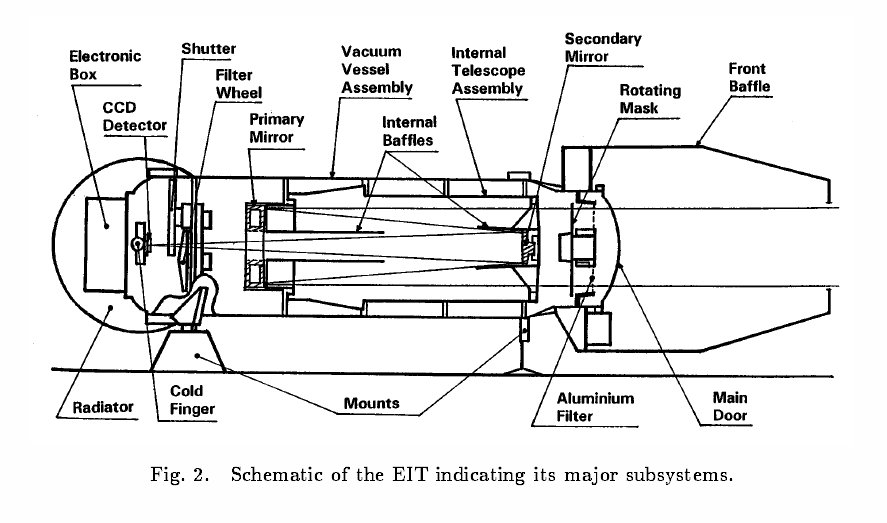
As you can see, it uses a system of mirrors to give the imaging camera a very large focal length.
Now let's explain about focus.
Take a look at the picture below:

As you can see in the left hand side of the picture, we are focused on the building, however there are flowers that are very close to the lens of the camera. They are out of focus and appear quite fuzzy.
On the right hand side of the picture the camera is focused on those flowers, and now the building in turn is out of focus and fuzzy.
This should be a clue for you when looking at any UFO pictures or videos, especially ones showing an object that is suppose to be near the sun.
If the object is truely near the sun, which is what the imaging satellite is looking and is focused on, then the object should be in focus just as much as the sun is.
If instead the object in the picture or video is very out of focus and fuzzy, that should be a good indicator that it's much closer to the imaging camera, and not right next to the sun which is in focus.
Another good indicator that the object you are seeing is very close to the imaging system and not right next to the sun, is if the imaging system uses a reflective system like the EIT on SOHO that I showed above.
When small objects that are very out of focus with these systems, they will be so out of focus (remember, these imaging systems have focal lengths that are in the thousands of millimeters) that they'll appear as a round, fuzzy blob. Even if it were a small cube, it would look round.
Another artifact you can get due to being a small object that is way too close to the reflective imaging system will be a round blurred blob with what looks like a hole in the middle of it.
Here is why. The reflecting system has a set up like this: a large primary mirror, with a secondary mirror centered above it:
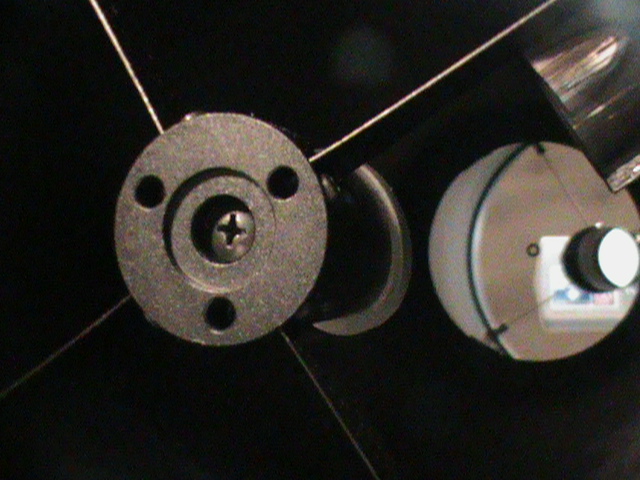
The secondary mirror will block light in the center of the primary mirror:
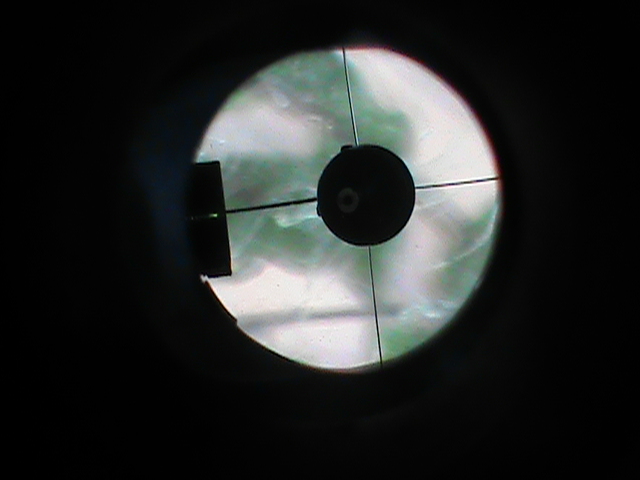
An object that is small and very close to this type of imaging system can give you round fuzzy blobs that look like they have a hole in the middle of them:

___________________________________
"Are you saying that every UFO that we look at in these pictures or videos must be this?"
No. What I'm saying is that having knowledge of how these imaging systems work, and how perspective views work can help you decide better if what you are looking at is really a UFO or something more mundane and ordinary.
Technically one could still call a object that is very small and close to the imaging system (instead of a huge, planet sized object right next to the sun) a UFO. It's way out of focus, can not be seen well, and we have no idea what it is (ice crystal? space junk?). There for it is a UFO.
The idea behind this thread is not to "debunk" anything, but instead to try and help ATS members be better observers in this field. Knowledge is power, and being informed on how things work can help enable a person's observational skills.
With the power of the internet in today's world, we have a multitude of people who can now cruise the internet and come upon all sorts of images and videos that people have posted and claimed that they are UFOs.
This has allowed any memeber here on ATS to watch a video on YouTube, or find a picture posted somewhere, and in turn bring it here to ATS for others to see. This can be a very powerful thing as it allows a large number of people to examine something.
However, part of the problem is that many times we have pictures and videos of things that memebers look at, but they lack the knowledge or education of the device that was used to take that picture or video.
Good examples of this are pictures or videos taken by satellites such as SOHO or STEREO, and ATS members will make posts that state such things as:
"That thing is HUGE!"
"That thing is right next to the sun!"
The problem with statements like these, is that in most cases, there is no way to really tell the size of the object or it's distance from the camera!
Let us take a look at what we call "Perspective View":
Using one of my computer SDKs (Software Development Kits), I've created a globe of the Earth. I've also created a very large object and set it next to the Earth as you can see in the picture below:

Let us imagine that we are a satellite that has imaged this.
Now let us take a look at the large white sphere from a different angle and much closer, with a reference object. The referece object is a large rock. I've sunk it into our large sphere:

As you can see, the white sphere is with out a doubt, a large object by the Earth.
Now take a look at this picture:

It looks the same as our first one: a large object next to the Earth.
But there is a problem here. We are assuming that this is a large object right next to the Earth. We did that with my first picture too actually.
But here is what this object in this picture really is:

It's a very small object, very close to the camera. There is my reference rock, and I've even put the actual large white sphere where it was before.
So when looking at these pictures and videos, before you state that it's something large and next to the sun (or another body), keep in mind that you do not know this for a fact without a change in perspective or some sort of reference.
Is there no way to tell from these pictures or videos?
Actually, there is a way to at least make what we call an "educated guess" of how far or close something might be.
It's called "Focus"
This is where understanding the device that took the image or video comes into play.
Many of the satellites in orbit have different types of imaging systems on them. Understanding how they work is very important if you want to understand what you might be looking at.
Some of these systems use telephoto types of lens. Some use reflective optics. The reasons for this is due to what type of focal length the camera needs.
The correct type of telephoto lens can zoom in on objects that are far away. The amount of zoom we get will depend on the optic's focal length. Here is a picture that shows the more we zoom in, the larger the focal length:

Telephoto lenses start to get large and heavy the larger you go. If you want even higher zoom capabilities, you'll start running into the problem of lens size. Making huge lenses for much higher focal length is a problem in that the glass when forming much larger lenses can have defects, gravity sag, and are extrememly expensive to make.
However, we know that by using a curved mirror, we can achieve much higher focal lengths than a telephoto lense by using much cheaper and easier to make thin mirrors.
A reflecting optical system does just that: gives us much higher focal lengths (in the thousands of millimeters) that is lighter, smaller and much cheaper.
Here is a picture of the EIT imaging system on the SOHO satellite:

As you can see, it uses a system of mirrors to give the imaging camera a very large focal length.
Now let's explain about focus.
Take a look at the picture below:

As you can see in the left hand side of the picture, we are focused on the building, however there are flowers that are very close to the lens of the camera. They are out of focus and appear quite fuzzy.
On the right hand side of the picture the camera is focused on those flowers, and now the building in turn is out of focus and fuzzy.
This should be a clue for you when looking at any UFO pictures or videos, especially ones showing an object that is suppose to be near the sun.
If the object is truely near the sun, which is what the imaging satellite is looking and is focused on, then the object should be in focus just as much as the sun is.
If instead the object in the picture or video is very out of focus and fuzzy, that should be a good indicator that it's much closer to the imaging camera, and not right next to the sun which is in focus.
Another good indicator that the object you are seeing is very close to the imaging system and not right next to the sun, is if the imaging system uses a reflective system like the EIT on SOHO that I showed above.
When small objects that are very out of focus with these systems, they will be so out of focus (remember, these imaging systems have focal lengths that are in the thousands of millimeters) that they'll appear as a round, fuzzy blob. Even if it were a small cube, it would look round.
Another artifact you can get due to being a small object that is way too close to the reflective imaging system will be a round blurred blob with what looks like a hole in the middle of it.
Here is why. The reflecting system has a set up like this: a large primary mirror, with a secondary mirror centered above it:

The secondary mirror will block light in the center of the primary mirror:

An object that is small and very close to this type of imaging system can give you round fuzzy blobs that look like they have a hole in the middle of them:

___________________________________
"Are you saying that every UFO that we look at in these pictures or videos must be this?"
No. What I'm saying is that having knowledge of how these imaging systems work, and how perspective views work can help you decide better if what you are looking at is really a UFO or something more mundane and ordinary.
Technically one could still call a object that is very small and close to the imaging system (instead of a huge, planet sized object right next to the sun) a UFO. It's way out of focus, can not be seen well, and we have no idea what it is (ice crystal? space junk?). There for it is a UFO.
Absolutely fantastic post. Flagged and starred....heck, this thing really ought to be stickied!
Awesome post! Very valuable for those of us who are NOT photography savvy!
S&F!
S&F!
At last, a good perspective post on imaging. Thanks for posting!
The perfect response to all those "look at this UFO on Soho" threads.
The perfect response to all those "look at this UFO on Soho" threads.
With the soho images one way to tell would be to look at the flares... If the suns flares are in front of the object then the object is next to the
sun or behind the sun. If the flares are behind the object then the object is closer to the camera. You can gain some kind of perspective from that.
Most of the objects I have seen are behind the flares, so they probably are some huge object.
Thank goodness. Kind of tired of threads showing a giant blob zip across SoHo or STEREO and someone assuming its some giant world-eating UFO. I'm not
saying that thoss don't exist but you should have the knowledge to know when your eyes are playing tricks on you.
Bravo and Well done! I am not a debunker but you must use science to prove to me an image contains a UFO.
Now to me this is what ATS is all about. great post OP. I read through it quickly but plan to study it in depth when I have time this evening...
Thanks guy!
Like I said, the thread isn't to debunk. Just educate is all.
While I do tend to play the skeptic, it's not because I don't believe life is out there, I do believe it most likely is.
I also believe that there are UFO's out there, I just don't make the "they're aliens" connection right away, as they are "Unidentified" in the first place.
But I do think they should be researched seriously, but I think the field is seriously hampered and is not taken seriously by so many, simply because of people that create hoaxes, help spread those hoaxes, or by people so seriously lacking in knowledge that they believe every single thing they see is a UFO.
So if a thread like this can help inform people better so that when they watch a YouTube video, they can make a better informed observation about it whether it's a case of mistaken identity, a hoax that someone did to get attention or their 15 minutes of fame, or if it's the real deal, then I'm glad that it helps.
Like I said, the thread isn't to debunk. Just educate is all.
While I do tend to play the skeptic, it's not because I don't believe life is out there, I do believe it most likely is.
I also believe that there are UFO's out there, I just don't make the "they're aliens" connection right away, as they are "Unidentified" in the first place.
But I do think they should be researched seriously, but I think the field is seriously hampered and is not taken seriously by so many, simply because of people that create hoaxes, help spread those hoaxes, or by people so seriously lacking in knowledge that they believe every single thing they see is a UFO.
So if a thread like this can help inform people better so that when they watch a YouTube video, they can make a better informed observation about it whether it's a case of mistaken identity, a hoax that someone did to get attention or their 15 minutes of fame, or if it's the real deal, then I'm glad that it helps.
edit on 26-6-2012 by eriktheawful because: (no reason given)
Good thread eriktheawful
I started a similar thread looking at this topic from a slightly different angle a few months back: How good are we at estimating the distance and altitude of UFOs?
I started a similar thread looking at this topic from a slightly different angle a few months back: How good are we at estimating the distance and altitude of UFOs?
reply to post by FireballStorm
That is a good thread and a good read.
I wish there was a sticky topic of these threads and required reading, hehehehe.
That is a good thread and a good read.
I wish there was a sticky topic of these threads and required reading, hehehehe.
reply to post by eriktheawful
NVM lost on sheep.
NVM lost on sheep.
edit on 26-6-2012 by Freezer because: (no reason given)
reply to post by abeverage
Hi, I'm new to this and this is my first post. Sorry if this isn't how you go about it. My son took this photo while taking off from Heathrow England airport last year bound for Atlanta USA. For you photographer people you may be able to work out the size of the craft he took a picture of?
img.abovetopsecret.com...
Hi, I'm new to this and this is my first post. Sorry if this isn't how you go about it. My son took this photo while taking off from Heathrow England airport last year bound for Atlanta USA. For you photographer people you may be able to work out the size of the craft he took a picture of?
img.abovetopsecret.com...
reply to post by tugslike
Looking at the photo, I am not familiar with the landscape, but I don't see anything jumping out at me either:
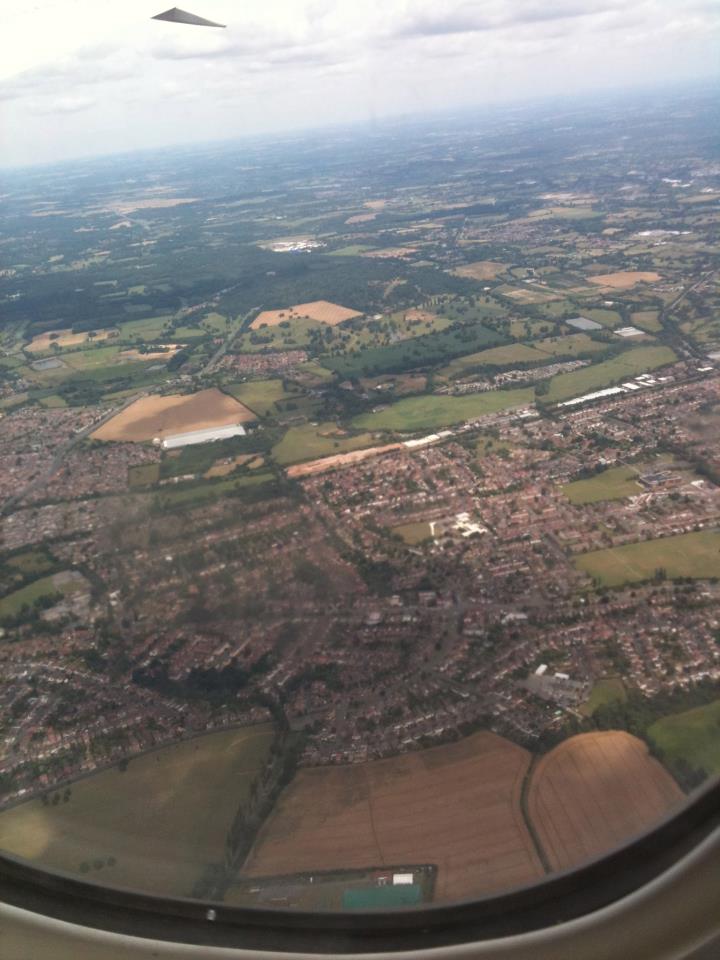
I see terrain, buildings roads, trees, and clouds. I can also see at the bottom of the photo the window frame of the aircraft he is in, and in the upper left hand corner of the photo looks like the wing of the air craft he is on, and that the plane is banking (turning).
Could you point out what is in the photo that we need to examine?
Looking at the photo, I am not familiar with the landscape, but I don't see anything jumping out at me either:

I see terrain, buildings roads, trees, and clouds. I can also see at the bottom of the photo the window frame of the aircraft he is in, and in the upper left hand corner of the photo looks like the wing of the air craft he is on, and that the plane is banking (turning).
Could you point out what is in the photo that we need to examine?
Yes, good informative post and makes a lot of sense too.
This is not trying to hijack the thread but illustrates the point the OP is making about perspective.
I came across this posted in the Daily Mail UK which shows an image of space and then is a greenish "asteroid" very much in focus. Now going by your in/out focus method of determining the size and distance it has either been added to the image by some joker at Google or else it looks to be rather close to the camera. One is rather worrying and the other is just example of Google not taking enough care when splicing together pieces of space.
This is not trying to hijack the thread but illustrates the point the OP is making about perspective.
I came across this posted in the Daily Mail UK which shows an image of space and then is a greenish "asteroid" very much in focus. Now going by your in/out focus method of determining the size and distance it has either been added to the image by some joker at Google or else it looks to be rather close to the camera. One is rather worrying and the other is just example of Google not taking enough care when splicing together pieces of space.
reply to post by eriktheawful
I found this a very informative post and would like to think that people who examine pictures and footage of aerial phenomena already have a good understanding of how camera and telescopic lenses work in relation to perspective. This post does give hobbyists and lay people with no interest in photography at least one other aspect to look into before jumping to conclusions and for that I applaud you S&F
I found this a very informative post and would like to think that people who examine pictures and footage of aerial phenomena already have a good understanding of how camera and telescopic lenses work in relation to perspective. This post does give hobbyists and lay people with no interest in photography at least one other aspect to look into before jumping to conclusions and for that I applaud you S&F
reply to post by eriktheawful
Hey Eriktheawful!
GREAT THREAD!!! S&F!
I am so happy you did this as I have been struggling with my lack of photography knowledge while looking at pictures.
peace,
AB
Hey Eriktheawful!
GREAT THREAD!!! S&F!
I am so happy you did this as I have been struggling with my lack of photography knowledge while looking at pictures.
peace,
AB
edit on 26-6-2012 by AboveBoard because: (no reason given)
Excellent! That explains a lot of pictures in where what you see is not always the truth.
This is why I come to ATS every night. I always learn something new!
This is why I come to ATS every night. I always learn something new!
new topics
-
Putin, Russia and the Great Architects of the Universe
ATS Skunk Works: 50 minutes ago -
A Warning to America: 25 Ways the US is Being Destroyed
New World Order: 5 hours ago -
President BIDEN's FBI Raided Donald Trump's Florida Home for OBAMA-NORTH KOREA Documents.
Political Conspiracies: 11 hours ago
top topics
-
President BIDEN's FBI Raided Donald Trump's Florida Home for OBAMA-NORTH KOREA Documents.
Political Conspiracies: 11 hours ago, 28 flags -
A Warning to America: 25 Ways the US is Being Destroyed
New World Order: 5 hours ago, 10 flags -
Gaza Terrorists Attack US Humanitarian Pier During Construction
Middle East Issues: 17 hours ago, 8 flags -
Las Vegas UFO Spotting Teen Traumatized by Demon Creature in Backyard
Aliens and UFOs: 16 hours ago, 7 flags -
2024 Pigeon Forge Rod Run - On the Strip (Video made for you)
Automotive Discussion: 16 hours ago, 4 flags -
Is AI Better Than the Hollywood Elite?
Movies: 12 hours ago, 3 flags -
Maestro Benedetto
Literature: 12 hours ago, 1 flags -
Putin, Russia and the Great Architects of the Universe
ATS Skunk Works: 50 minutes ago, 1 flags
active topics
-
What in the S.E.O. hell is this?
General Chit Chat • 27 • : reannamurphy -
Putin, Russia and the Great Architects of the Universe
ATS Skunk Works • 7 • : RussianTroll -
"We're All Hamas" Heard at Columbia University Protests
Social Issues and Civil Unrest • 286 • : FlyersFan -
A Warning to America: 25 Ways the US is Being Destroyed
New World Order • 9 • : Lazy88 -
President BIDEN's FBI Raided Donald Trump's Florida Home for OBAMA-NORTH KOREA Documents.
Political Conspiracies • 21 • : CriticalStinker -
SETI chief says US has no evidence for alien technology. 'And we never have'
Aliens and UFOs • 75 • : Hecate666 -
Las Vegas UFO Spotting Teen Traumatized by Demon Creature in Backyard
Aliens and UFOs • 13 • : FlyersFan -
Mood Music Part VI
Music • 3105 • : BrucellaOrchitis -
The Acronym Game .. Pt.3
General Chit Chat • 7752 • : bally001 -
Is AI Better Than the Hollywood Elite?
Movies • 18 • : Hecate666
